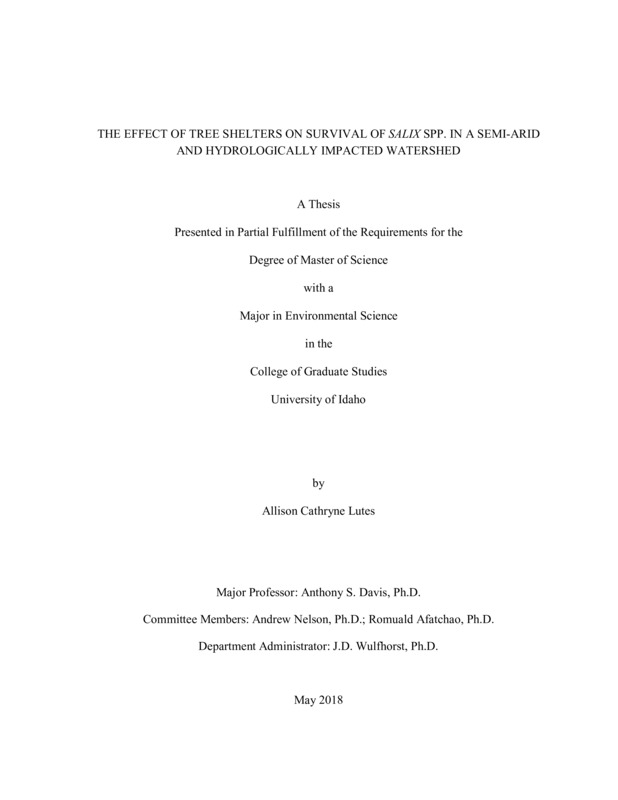THE EFFECT OF TREE SHELTERS ON SURVIVAL OF SALIX SPP. IN A SEMI-ARID AND HYDROLOGICALLY IMPACTED WATERSHED
Lutes, Allison Cathryne. (2018-05). THE EFFECT OF TREE SHELTERS ON SURVIVAL OF SALIX SPP. IN A SEMI-ARID AND HYDROLOGICALLY IMPACTED WATERSHED. Theses and Dissertations Collection, University of Idaho Library Digital Collections. https://www.lib.uidaho.edu/digital/etd/items/lutes_idaho_0089n_11335.html
- Title:
- THE EFFECT OF TREE SHELTERS ON SURVIVAL OF SALIX SPP. IN A SEMI-ARID AND HYDROLOGICALLY IMPACTED WATERSHED
- Author:
- Lutes, Allison Cathryne
- Date:
- 2018-05
- Program:
- Environmental Science
- Subject Category:
- Ecology; Natural resource management
- Abstract:
-
Many riparian areas in the arid west have become highly altered ecosystems that no longer undergo the underlying physical processes and disturbances that were essential to their formation. With the de-coupling of riparian zones from these natural processes, the loss of complexity in riparian zones has become a widespread problem. Due to the rapid rate of decline, great efforts have been made in the last quarter-century to attempt to restore these altered riparian areas and their plant communities to natural conditions. However, many of these underlying physical processes (over-bank flooding, sediment deposition cycles, etc.) are now controlled by larger systems such as complex water infrastructure projects that cannot be easily un-done given the growing demand for resources. Therefore, novel restoration approaches are needed to aid riparian plant communities in overcoming challenging site conditions that are not conducive to plant survival.
This study tested the use of vented and unvented tree shelters on two species of willow (Salix lasilepis Benth. and Salix laevigata Bebb) in a riparian zone within the Shasta River watershed in north-central California to determine the effect of tree shelters on survival. Dormant willow poles were planted into 0.92 meter augered holes and planted into the winter groundwater table. The results of this study indicate that the two shelter treatments varied in their effect on willow survival, and the effect differed between species. Red willows planted in unvented tree shelters were three times more likely to survive than red willows in the control treatment, indicating that this is a successful planting methodology that can improve survival for this species under similar conditions. In comparison, arroyo willows in either tree shelter treatment were not significantly more likely to survive than those in the control treatment. However overall survival for arroyo willows after 24 months was very high across treatments, suggesting that it is robust enough to tolerate the site conditions and that the investment in tree shelters may not be worthwhile for this species.
- Description:
- masters, M.S., Environmental Science -- University of Idaho - College of Graduate Studies, 2018-05
- Major Professor:
- Davis, Anthony S
- Committee:
- Nelson, Andrew; Afatchao, Romuald
- Defense Date:
- 2018-05
- Identifier:
- Lutes_idaho_0089N_11335
- Type:
- Text
- Format Original:
- Format:
- application/pdf
- Rights:
- In Copyright - Educational Use Permitted. For more information, please contact University of Idaho Library Special Collections and Archives Department at libspec@uidaho.edu.
- Standardized Rights:
- http://rightsstatements.org/vocab/InC-EDU/1.0/

